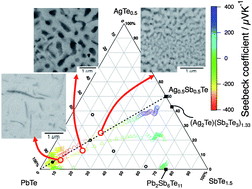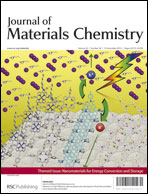A combinatorial approach to microstructure and thermopower of bulk thermoelectric materials: the pseudo-ternary PbTe–Ag2Te–Sb2Te3 system
Abstract
The microstructures and Seebeck coefficients of thermoelectric alloys in the pseudo-ternary PbTe–Ag2Te–Sb2Te3 system were examined using samples that were compositionally graded by unidirectional solidification by the Bridgman method and diffusion couples. At compositions near the middle of the pseudo-binary PbTe–AgSbTe2 line, a compositionally modulated microstructure has been found. From diffusion couple experiments, it is found that the PbTe–AgSbTe2 system exhibits a miscibility gap at low temperatures while it forms a complete solid solution at high temperatures; the critical temperature is between 400 °C and 450 °C. The modulated microstructure originates from the decomposition of the high-temperature solid solution during cooling. Scanning Seebeck coefficient measurement on these samples covers a wide compositional space of the pseudo-ternary system. The Seebeck coefficient transitions from positive values at AgSbTe2-rich compositions to negative values at PbTe-rich compositions on the pseudo-binary PbTe–AgSbTe2 line. Composition-graded samples prepared by the Bridgman method are thus useful to investigate thermoelectric materials in multi-component systems.

- This article is part of the themed collection: Nanomaterials for Energy Conversion and Storage

 Please wait while we load your content...
Please wait while we load your content...